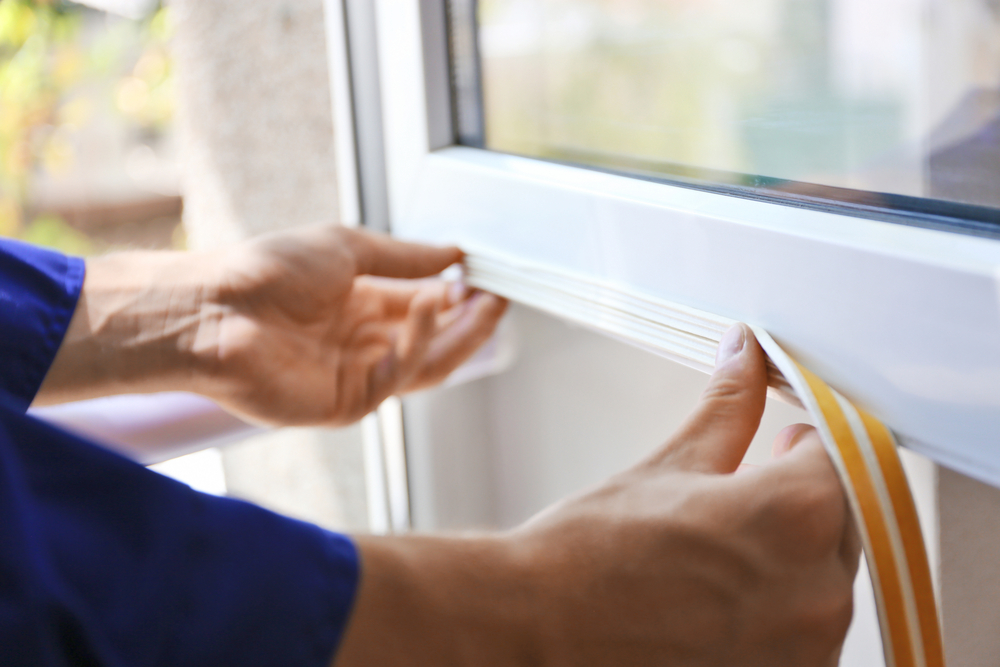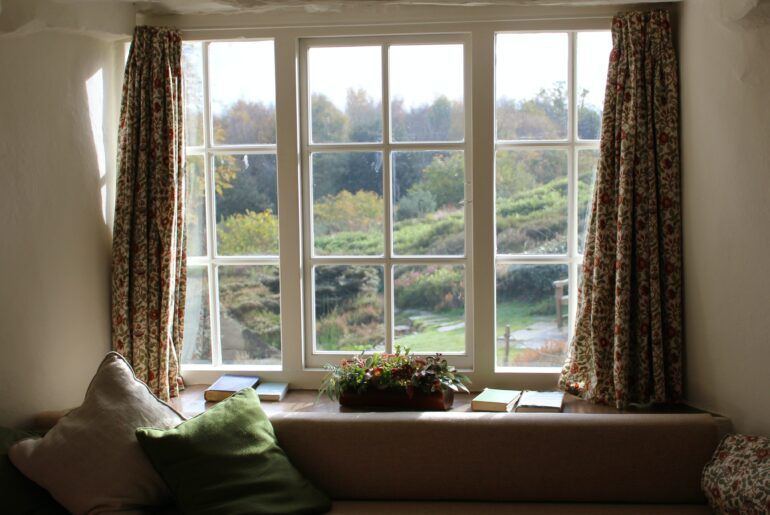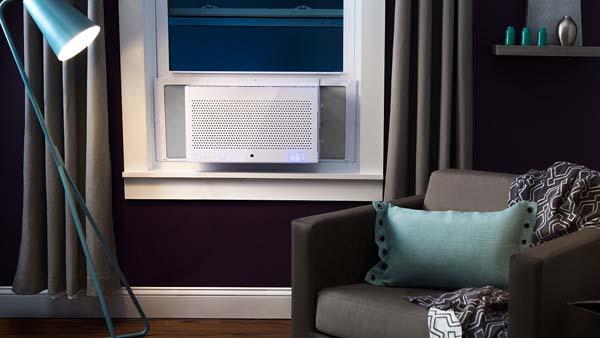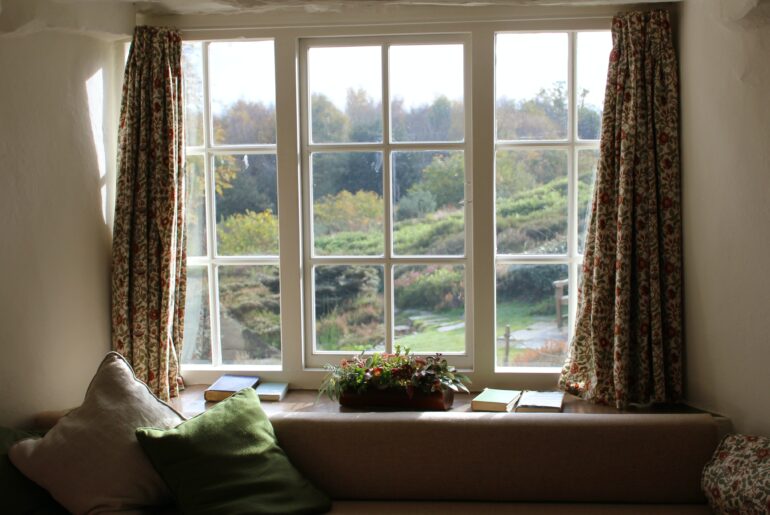As the temperature heats up and energy prices rise, the cost to cool a home can be significant. Many homeowners wonder if there are any do-it-yourself window treatments they can install to help conserve energy. Window insulation for summer use can reduce your energy bills while making your home more comfortable.
The energy escaping through windows and doors can account for 25% of a typical summer energy bill. Older windows, for example, can allow heat and cooling to escape through the glass, between the panes, and around the frame. Knowing how to insulate windows to keep heat out in summer will likely make a noticeable difference you can feel.
Most homes have around ten to twelve windows, so uninsulated windows allow the heat to accumulate. Making a few simple updates and repairs to your windows can save more in energy expenses than the updates cost. DIY window insulation is simple to install and most solutions require just a few hand tools.
Here we will offer tips and suggestions to help make your windows more energy efficient without replacing them.
Is Windows Insulation Necessary To Keep Heat Out?
Adding window insulation can have a marked effect on the energy escaping a window and frame. If your windows are leaking air, they can also leak water. You will want to treat both conditions, though not in the same way. Window insulation can also come in the form of window film, cellular shades, blinds, shutters, and overhead shade.
Any material used to impede the transfer of heat into the home will have a cumulative effect, so a combination of shade, UV reflection, and insulation will usually have the greatest effect.
Windows can cost you money in a couple of ways, so they must both be addressed. The first is when they let conditioned air escape, and the second is when they allow the UV radiation from sunlight to enter the home as heat. We will address each separately, although some updates will affect both problems.
What is the Best Way to Insulate My Windows?
As mentioned earlier, you need to address both drafts and UV radiation to reduce the heat entering and cool air escaping the home. The best way to insulate old windows will be determined by the condition and type of window.
Deciding what to put on windows to keep the heat out might involve temporary insulation and/or permanent insulation. For example, often the best way to insulate an apartment window is with cellular shades or paper shades because they can be easily removed when the occupant leaves.
Here we will discuss insulating the individual components of a typical window, which are the glass, the frame, and the sashes. Insulating any of the three will help, but insulating all of them is the most effective solution.
What is the Best Way to Insulate Windows in Summer?
The best way to insulate windows in summer is to start with the glass since that represents most of the heat gain. The insulating film, cellular blinds, and curtains can reduce heat transmission by 80% or more. Stopping drafts and reflecting heat are some of the best cheap ways to block heat from a window.
Drafts caused by under-insulated frames and out-of-square sashes should be addressed as well using weatherstripping and loose fiberglass batting.
Insulating the Glass
Option 1. Install Window Film
Cost: $316 – $908 total (per Homeadvisor)
One popular option involves installing a UV filtering transparent film over the glass. In a sense, this is like putting sunglasses on your windows. The film is self-adhesive and reflects the UV radiation from sunlight. Some forms are DIY-friendly, but the most effective films will usually require a few special tools to install.
Pro:
Window film is very effective, relatively inexpensive, and does not greatly inhibit natural light. Window film is available in many shades, just like sunglasses, depending on the problem you need to solve.
Con:
Window film is not particularly easy to install, so if the film will be in a prominent place like a two-story foyer, investing in professional installation is recommended.
Installation Tip: If you do want to try it yourself, make sure the window is perfectly clean before installing the film. Any debris left on the window like grease, dust, or fingerprints will prevent the film from contacting the glass, resulting in a bubble.
Option 2.Install Cellular Shades
Cost: $25 – $150 (per shade)
Cellular shades (also called honeycomb shades) are designed to create air pockets, or cells, used as insulation against UV radiation. Cellular shades are also much more durable than blinds because most designs prevent them from twisting together accidentally.
Cellular shades create a barrier between the heat passing through your windows and the room. Because cellular shades have more surface area than blinds, many are made from easy-to-clean fabric like polyester.
Cellular shades work much like fiberglass, cellulose, and expanding foam insulation to create pockets of air that impede heat from passing through. Many also contain reflective surfaces that reflect much of the heat back away from the glass. Cellular shades are also available in various colors to control the light as well.
Pro:
Cellular shades are inexpensive, easy to install, and very effective at preventing UV radiation from entering the room. Cellular shades are also stackable, so if you need more insulation, you can install them on top of each other. Stacking cellular shades offer the greatest insulation R-value to a non-low energy window.
Con:
As great as cellular shades are for controlling heat, they do so in a very opaque way. Cellular shades are not transparent, so they offer little control of natural light, other than blocking it. Some cellular shades, however, are translucent and made from lighter color fabrics that may pass broken light.
Installation Tip: Use screws to attach the mounting bracket for cellular shades, not nails. By using small screws (usually #6 panhead wood screws), a small hole is made in the interior window frame or casing instead of a large one like a nail might cause.
If you need to replace your shades with a different color or add additional shades later, removing and replacing screws will be much easier and result in less damage to the frame or casing.
Option 3. Add Insulating Shutters
Cost: $145.00 – $347.00/Pair
Adding insulating shutters may be an option in some home designs. Insulation shutters control much of the UV radiation contacting the glass because many can be opened and closed. To be effective in summer, these shutters should remain closed, blocking the sunlight as well.
Most insulating shutters consist of a foam core sandwiched between two layers of fiberglass, vinyl, or aluminum. When the shutters are closed, a loose pocket of air is created between the backside of the shutter and the window. The air acts as an insulator, impeding the heat from contacting the glass.
Pro:
Shutters provide the flexibility of blinds and shades, but also protect the window from physical damage when closed. Shutters can last as long as the house if properly maintained, so the return on investment is high.
Con:
Shutters can be a chore to install, plus they may be the most expensive window insulation solution. The initial expense must be considered because shutters are often a focal point of curb appeal. You probably can’t just add shutters to one window, so the additional expense can be significant.
Option 4. Add Interior Shutters (Plantation Shutters)
Cost: standard sizes $150.00 per pair
Cost: custom sizes $150.00 – $300.00 per pair
Long before we had HVAC systems, homeowners used shutters to keep the sun’s heat from heating up the interior of the home. Today, we have more options, like interior shutters. Also known as plantation shutters for their common use in the southern US, interior shutters usually include wide slats or louvers to block sunlight.
Interior shutters work just like exterior shutters, except they are installed on the interior window frame instead of the home’s exterior. Interior shutters are attractive in any home style, so they appeal to more homeowners. Interior shutters are also very easy to access, so they tend to get used more often.
Pro:
Interior shutters are both an aesthetic improvement and a functional one because they control natural light in a very attractive way. Interior shutters essentially create a pocket of air between the window and the interior, while blocking the UV radiation. Interior shutters are durable and can last as long as the home with proper care.
Con:
Interior shutters really only have one downside, which is the upfront cost. Some off-the-shelf versions can be installed by do-it-yourselfers, while custom versions will likely require professional installation.
Installation Tip. Make sure your interior shutters are hung perfectly square and plumb with both the window frame and each other. Much like french doors, shutters are designed to gently come together evenly. If one or both of the shutters are out of plumb or square, they will either not close or create a gap between the shutters.
Option 5. Add Blinds
Cost: $20 – $120
An inexpensive option may include using a window dressing like blinds. Temporary blinds are very inexpensive, but even custom, made-to-order blinds are less expensive than new windows. The advantage to blinds, (especially plantation style), is that the blades can be turned in different directions without raising the blinds.
In the summertime, the horizontal blinds can be pointed up, which tends to reflect the south-facing morning sun. In the afternoon, blinds on the west-facing side can be easily pointed downward to reflect an eastward-facing sunset. Vertical blinds can be used for the same effect and are usually available in larger sizes than the horizontal version.
Option 5. Paint Your Windows
Cost: $20.00 – $25.00 total
Some creative homeowners use paint to deal with uncontrolled heat passing through old windows. For example, children’s rooms, playrooms, kitchens, and dens are often personalized for the occupant.
Why not let the kids paint a design on the glass using acrylic paints? Acrylics are easily scraped off and water-soluble, making them ideal for temporary artwork that also blocks unwanted natural light.
Insulating the Frame
Cost: $15.00 – $20.00 per window
Insulating the frame of a window will usually involve foam rope, expanding spray foam, and fiberglass batts. However, before any insulation is installed, the frame must be weatherproofed. Weatherproofing can be done with aluminum flashing, caulk, or both.
When we discuss insulating a window frame, we really mean insulating the space around the window frame. First, a weather-tight seal must be established on the exterior to prevent damage to the insulation. In most cases, this is done with exterior grade caulk, but the addition of aluminum flashing is the best solution.
Insulation rope, also known as draft snake, is foam insulation in the form of a long rope. Available in various sizes, insulation rope is used to fill long, narrow gaps between the frame and the rough opening of the window. Another name for the product is a caulk saver because it can replace the long beads of caulk needed to fill large gaps.
Insulating the Sashes
Cost: $8.00 – $10.00 per window
Insulating the sashes of a window really describes adding weather stripping to the edges and replacing any seals between the sashes. Window sashes can be made from wood, aluminum, fiberglass, or most likely vinyl. Modern window sashes usually include either fiberglass batting or foam insulation inside the hollow sash. Wooden windows, however, rely on the wood itself.
To insulate a window sash, you need to determine where the sash is not contacting the frame or the other sash that is causing the leak. Weatherstripping is then added in small increments to the edge not making contact with the frame. Weatherstripping is usually a very thin (⅛”-¼”) strip of foam with self-adhesive backing.
Once the weatherstripping is installed, the foam will remain its normal thickness until it contacts the frame or sash. The pressure exerted by the sash when it is closed compresses the weatherstripping as needed, forming an effective seal.
Pro:
Weatherstripping is a cost-effective way to stop drafts around your window sashes. Weatherstripping is a great first-time home improvement project because it is simple, very effective, and inexpensive.
Con:
Unlike some other window insulation products, weatherstripping must move with the sash. The movement means the weatherstripping will need replacing much more often than frame insulation. Weatherstripping is often exposed to the elements, so proper maintenance is required.
Installation Tip. Don’t remove the self-adhesive tape backing until you are ready to place the weatherstrip. Apply the weatherstrip in increments of an inch or two at a time, removing only enough backing as needed. If the weatherstrip is allowed to touch itself without the backing, the sections will instantly bond together and you’ll have to start over.
What’s The Cheapest Way to Insulate Windows For Summer?
The cheapest way to prevent your windows from allowing heat into the home is to use bubble wrap or blackout shades. Both are very inexpensive, if unattractive. Bubble wrap has the advantage of passing some light through while using the bubbles to prevent heat from passing.
Blackout shades essentially block both the heat and the light, but do so effectively. Blackout shades and bubble wrap are usually installed with inexpensive masking or packing tape. Using tape makes removing either material easier in the future without damaging the window.
What Are Your Best DIY Options For Windows Insulation?
Your best DIY options will usually be a combination of cost and easy installation. Options that meet these criteria include:
Standard Blinds
Standard-sized vinyl blinds are generally the most popular when cost and easy installation are important. DIYers with even minimal skills can install ready-made blinds. Some will have the traditional cord, while others are cordless and are opened simply by lifting them.
Cellular Shades
Standard-size cellular shades are inexpensive and lightweight, making them easy to purchase and install by a do-it-yourselfer. Cellular shades block most of the natural light as well, so they are ideal for nurseries and other rooms where people sleep during the daytime.
Does Plastic On Windows Help In Summer From Heat?
Does insulation window film for summer really help? Does window insulation film work in summer? Adding certain types of plastic to your windows can have a marked effect in reducing summer heat. Plastics, like Mylar, do a good job of trapping heat between the plastic and the glass, impeding the heat from entering the room.
As described earlier, reflective window insulation and reflective foil for windows can reduce the heat entering the room dramatically.





